Table of Contents
- What is a sales projection?
- Sales Projection Examples
- What are the benefits of sales projections?
- How to Create a Sales Projection
- Types of Sales Projection Tools You’ll Need
- Sales Projection Tools
- Tips for Making Sales Projections
What is a sales projection?
A sales projection estimates future sales revenue over a particular period. It’s made by analyzing historical sales data, identifying patterns and trends, and using that past information to predict the revenue the department will generate in the future.
Here are just a few considerations you might use when building a sales projection:
- The economic factors that could affect the business.
- The current state of the market and the position the business occupies within it.
- Your budget for customer acquisition.
If you’re launching a new product or feature, the sales team will try to project sales for three scenarios: the best-case scenario, the worst-case scenario, and the most likely scenario — which is usually the middle ground between the first two.
I’ve found sales projections are critical because they allow companies to set realistic sales goals, track their progress over time, and estimate future revenue.
Because the accounting department uses sales projections to determine the budgets for different areas of the business, estimate financial outcomes, assess financial risk, and conduct overall business planning, it will be difficult to make data-driven decisions or set SMART sales goals without accurate projections.
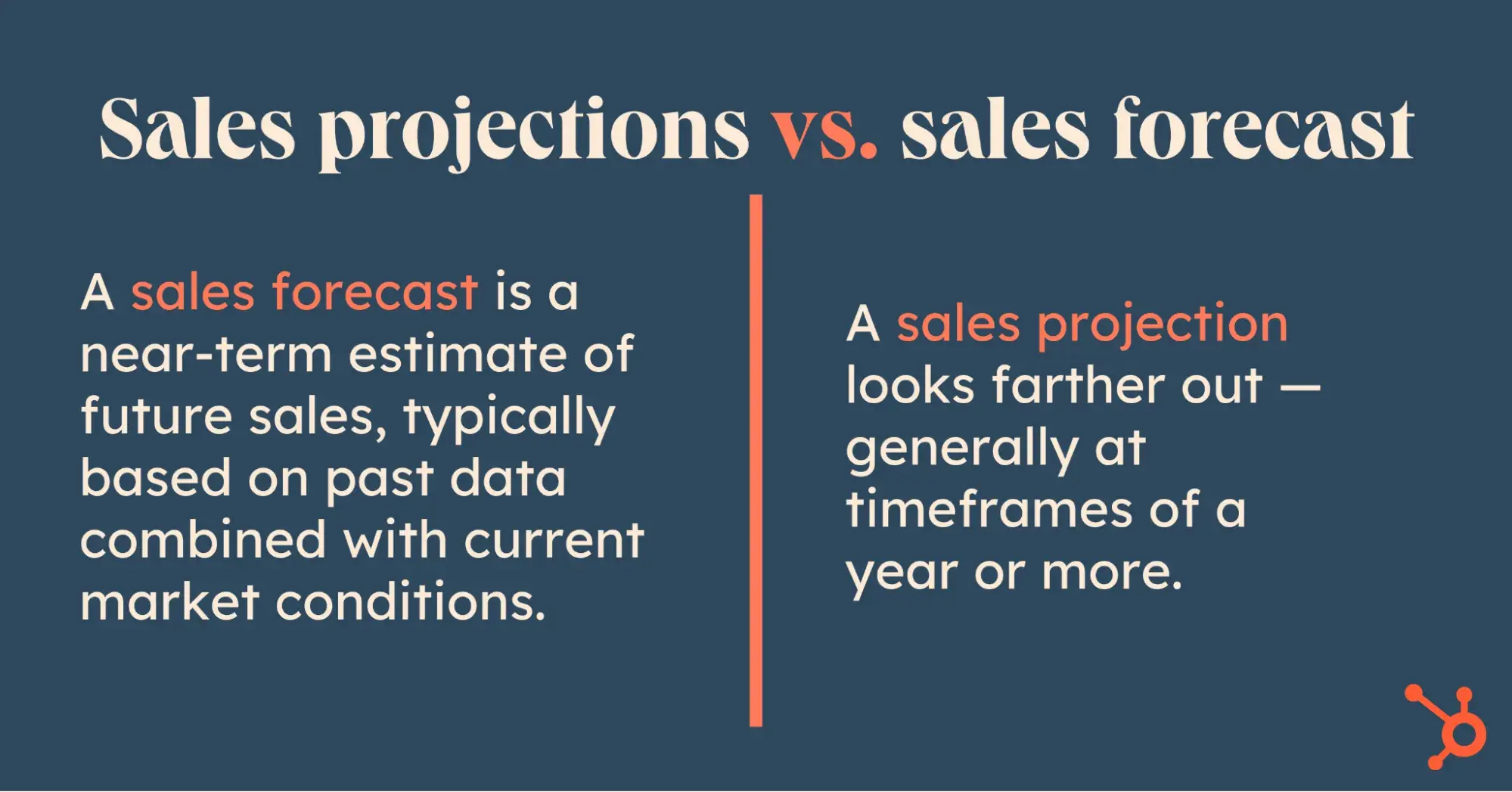
Sales Projections vs. Sales Forecast
I’ve heard some sales professionals use “sales projection” and “sales forecast” as if these terms were interchangeable, but in my opinion they’re actually distinct (although admittedly with some overlap).
A sales forecast is a near-term estimate of future sales, typically based on past data combined with current market conditions. It will look anywhere from one to six months out, with quarterly perhaps the most common duration, and many organizations update it regularly as new relevant information emerges.
The sales forecast is data-driven, and it’s ultimately supposed to be a realistic guess at sales revenue in the coming months to help inform a variety of other business functions.
A sales projection, on the other hand, looks farther out — generally at timeframes of a year or more. It’s also data-driven and used for planning purposes by other parts of the business, but it factors in growth goals from leadership and the sales department.
As a result, I see the sales projection as a more aspirational estimate than the cut-and-dry forecast, describing what the company hopes to achieve if the sales department can meet ambitious but nonetheless realistic goals.
Sales Projection Examples
Because most companies aren’t particularly forthcoming with their current sales projections, I went ahead and created two examples for SaaS companies that should give you an idea of what your own projections might look like.
Example 1: SaaS Company Offering Marketing Automation Software for SMBs
Company Profile
- Product: Marketing automation platform targeting small to medium-sized businesses (SMBs).
- Pricing Model: Subscription-based, with monthly and annual plans.
- Current ARR (Annual Recurring Revenue): $1 million.
- Goal: Reach $2.5 million ARR by the end of the year.
Projection Assumptions
- Customer Acquisition Rate: The company plans to increase marketing spend and expects a 10% monthly increase in new customer acquisition.
- Churn Rate: The average customer churn rate is 2% per month, consistent with the company’s historical data.
- Expansion Revenue: The company introduces add-ons and anticipates 5% of customers upgrading within 6 months, leading to an ARR increase.
|
Month |
Starting ARR |
New ARR from Acquisitions |
Lost ARR (Churn) |
ARR from Upgrades |
Ending ARR |
|
January |
$1,000,000 |
$100,000 |
$20,000 |
$0 |
$1,080,000 |
|
February |
$1,080,000 |
$110,000 |
$21,600 |
$5,400 |
$1,173,800 |
|
March |
$1,173,800 |
$121,000 |
$23,476 |
$5,869 |
$1,277,193 |
|
… |
… |
… |
… |
… |
… |
|
December |
$2,588,255 |
$285,312 |
$51,765 |
$13,094 |
$2,834,896 |
Projection Summary
This projection anticipates a consistent increase in ARR primarily driven by new customer acquisition and limited customer churn. The addition of upgrades from existing customers through add-ons supports a steady revenue increase, aligning with the company’s $2.5 million ARR goal by year-end.
In my experience, many sales projections take a similarly optimistic tone with an ending ARR that exceeds the stated goal. This practice builds some flexibility into the projection if the sales department underperforms a few months out of the year.
Example 2: B2B Enterprise Software Company Offering a Data Analytics Platform
Company Profile
- Product: Data analytics software designed for large enterprises.
- Pricing Model: Annual contracts with an average deal size of $100,000.
- Current ARR: $5 million.
- Goal: Achieve a 30% ARR growth, targeting $6.5 million ARR by year-end.
Projection Assumptions
- New Deals: The company expects to close five new deals per quarter, contributing $500,000 in ARR each quarter.
- Churn Rate: Due to contract expirations and competition, the company experiences an annual churn rate of 5%, applied quarterly at 1.25%.
- Expansion Sales: The sales team aims for a 10% upsell rate on existing contracts by offering additional features and consulting services.
|
Quarter |
Starting ARR |
New ARR from Deals |
Lost ARR (Churn) |
ARR from Upsells |
Ending ARR |
|
Q1 |
$5,000,000 |
$500,000 |
$62,500 |
$50,000 |
$5,487,500 |
|
Q2 |
$5,487,500 |
$500,000 |
$68,594 |
$54,875 |
$5,973,781 |
|
Q3 |
$5,973,781 |
$500,000 |
$74,672 |
$59,738 |
$6,458,847 |
|
Q4 |
$6,458,847 |
$500,000 |
$80,736 |
$64,588 |
$6,942,699 |
Projection Summary
With ARR from upsells helping to offset the organization’s lost ARR from churn, the added ARR from new deals adds up fast, helping the sales team reach the $6.5 million goal in this projection.
As I explained in Example 1, the projection has a built-in buffer of almost $500,000, helping ensure the company can still reach its goals if there are one or two slow quarters hampering growth.
What are the benefits of sales projections?
Projecting sales (and revenue) helps business leaders make informed decisions about business operations and track the company’s progress toward long-term goals and objectives. Below are several reasons why sales projections are important.
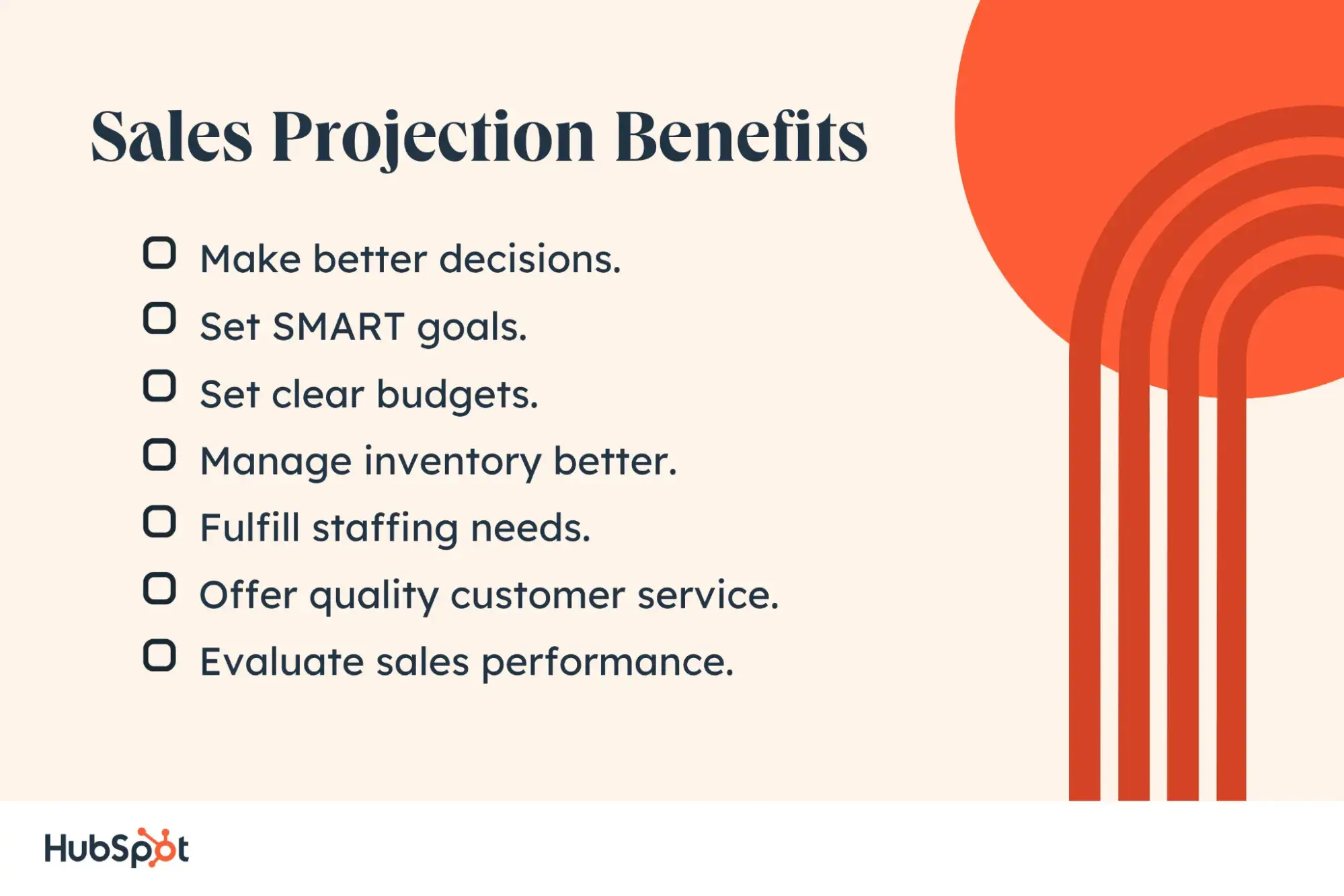
1. Make better decisions.
Sales projections provide important data that helps business leaders make informed decisions about product pricing, finances, staffing needs, marketing strategy, and sales processes. Business teams usually have more confidence in these decisions when they’re made on real projections instead of a whim.
For example, I’ve used sales projections to help my teams take a more informed approach to pricing negotiations that made them and the company more money. Knowing we were in a period of relatively high demand, we were able to draw a harder line on price — and it turned out most prospects were willing to pay what we asked for.
2. Set SMART goals.
Sales representatives are usually ambitious people who try to exceed their quotas; however, asking them to close more deals than is realistically possible will cause them to lose their enthusiasm and love for their jobs — which translates into unmet quotas and reduced revenue.
Sales projections help you set attainable goals based on hard data. While my own anecdotal experience tells me goals are a cornerstone of success, there’s also a wealth of scientific research on the power of goals dating back almost a century. Indeed, McKinsey has called goal setting one of the four basic elements of performance management. Better goals lead to better outcomes.
Pro tip: Need help making a sales plan? Check out HubSpot’s free sales plan template.
3. Set clear budgets.
Accurate sales projections show patterns in economic growth potential and revenue. Factoring in these forces allows you to balance cost and revenue and allocate your resources to the right teams and channels.
You’ll also be able to predict how much capital you’ll have available during the projection period, enabling you to make investments in new software or critical personnel training that deliver a tangible return.
In my experience, a team without a reliable sales projection is one too paralyzed with fear to make necessary expenditures. Running the numbers in a sales projection gives you the confidence to invest wisely.
4. Manage inventory better.
If you’re selling physical products, a sales projection will help you decide how much inventory you need and which products to stock. Inventory is expensive, and Netstock’s 2024 Inventory Management Benchmark Report found that the largest SMBs with 500+ employees had a 44% overstock rate.
With more accurate sales projections, you can do a better job meeting the precise needs of your customers, improving customer satisfaction, lowering costs, and boosting profitability as a result.
5. Fulfill staffing needs.
An accurate sales projection helps you determine how many salespeople you need to handle the predicted deals. If your projection requires you to have more people on the team, you’ll be able to hire, onboard, and train newcomers to handle the number of deals you anticipate in a given period.
I also find sales projections useful for identifying subtle seasonal trends and other changes in an industry that may have escaped notice. Thanks to accurate projections, I’ve occasionally been able to rely on freelance talent to get through temporary periods of increased demand without sacrificing customer experience or overstaffing.
6. Offer quality customer service.
I won’t name any names here, but I have no trouble recalling my worst customer service experiences. Accurate sales projections can actually help prevent these brand-breaking moments by helping you prepare your customer success teams.
If you know you’ll have X more deals during an end-of-quarter blitz, leadership can prepare your customer support team to efficiently handle calls, emails, or chats coming through from prospects and customers by arming personnel with resources such as templates and automation tools to make their jobs easier and more scalable.
7. Evaluate sales performance.
A sales projection is based on performance over time. If you estimated your team will close $1 million worth of deals in the first half of the year and you end up bringing in $700K, you’ll know to investigate further.
You could have a weak link in your team or process, or you might have had a particularly strong previous year that’s simply impossible to replicate. Either way, the act of scrutinizing the results of your projection may help you discover new ways to improve your sales process.
How to Create a Sales Projection
To create an accurate sales projection, here are six steps I recommend you follow.
1. Identify potential sales opportunities.
The first step to creating a sales projection is identifying potential sales opportunities. To do that, consider these four things:
- Products. Specify the kinds of products you’re selling (or have sold). Do these products satisfy your prospects’ needs? How will selling these products contribute to the business’s sales goals?
- Services and solutions. If your company offers services and/or solutions alongside products, consider the additional revenue you’ll potentially generate from those as well.
- One-time payments. If people only need to pay for your product once, you need to consider the number of units you’ll need to sell to meet your sales goals.
- Subscriptions. If you use the subscription business model, factor in monthly and annual subscription renewals into your quantitative data for making your sales projection.
Note: An organization can use both one-time and subscription-based payments as part of their broader sales strategy.
2. Review historical data.
The best way to ensure that your sales projections are accurate is to thoroughly analyze data from previous years, including the number of leads you got, how many you converted, and how many you lost. This data can give you a better understanding of sales trends, market conditions, and effective sales techniques — all of which will determine your projections for the future.
Matthew Ramirez, the owner of Rephrasely, understands how historical data can be a reliable basis for more precise projections.
“If a company is aware that 10% of the visitors to their website make a purchase, they can employ this information to form an estimation regarding the volume of sales they will generate from a particular number of website visitors,” Ramirez says.
“By establishing a correlation between the current data pertaining to the sales funnel and future sales objectives, one can derive a more precise understanding of the performance of their sales.”
Note: Sales professionals typically use customer relationship management (CRM) tools and other dedicated sales management software discussed in the next section to track sales opportunities, customer contact details, history, and outcomes.
3. Examine market factors and seasonality.
After reviewing historical data, analyze your market environment to determine potential growth areas within your industry. Note any obstacles that could hinder you from achieving your sales goals for the projected period (i.e., next quarter or next year).
Try to estimate possible changes in customer behavior due to external factors, such as economic conditions and political climate. For example, I’ve found that election seasons like the one we just finished heightened uncertainty and might cause business leaders to delay major purchasing decisions.
Consider both short-term fluctuations due to seasonality (e.g., holidays and periods of demand spikes) as well as long-term shifts. These trends can result from technological advancement or other disruptive forces that impact traditional buying patterns.
4. Gather information from your sales team.
Next, gather qualitative data about the individual contributions of your sales team and their sales process. Ask your team about the following.
Quotas
Ask each team member about their current sales quotas, i.e., the minimum amount of sales/revenue that a salesperson must generate in a month, quarter, or year. Knowing your team members’ sales expectations can help you set realistic sales goals for them.
Pricing
Knowing the value of the products and/or services being sold helps you make accurate projections because you’ll be able to multiply the revenue of a deal by the projected number of closed sales opportunities.
Sales Cycle
A sales cycle is the amount of time it takes to complete a sale. It starts with the initial contact of a prospect and ends with a payment. Different products and services have varying sales cycles, so understanding the cycle for each of your offerings will help you get accurate numbers.
5. Identify sales goals.
Sales goals are measurable objectives that guide sales teams through their day-to-day sales activities and help them make strategic business decisions. These goals are usually based on sales KPIs and metrics, such as win rate, year-over-year (YoY) growth, and total revenue.
I’ve learned that setting realistic sales goals is crucial to making accurate sales projections. Here are three things to consider when setting sales goals for your company.
Your Sales Team’s Capacity
If your sales team has enough members to operate in different geographic locations, you can set large goals for them. But if you have a small, locally-focused team, goals should reflect that scale.
The Composition of Your Products/Services
Determining if your products are “low cost–high volume” or “low volume–high cost” can help you create realistic sales goals. For instance, if your products are low cost–high volume, you’ll focus on the number of sales made. But if you have a high cost–low volume business, you’ll focus more on the total value of sales (in dollars).
Sales Initiatives
If your team has any upcoming sales or marketing initiatives on the calendar, factor them into the goals you set. These initiatives to boost sales may include expanding into new markets or launching new products or marketing campaigns.
6. Make assumptions and adjust as needed.
By now, you have most of the data you need — both quantitative and qualitative — to make accurate sales projections. Bear in mind that projecting sales and revenue is a complicated process with a wide variety of factors.
Instead of getting lost in the details, make assumptions quickly and adjust as you analyze the data. I like to pick a fictional number to represent our projected future sales and then reverse engineer what’s needed (resources and conditions) to achieve it. I do the calculations to help us review the likelihood of achieving our chosen number and then adjust the fictional number and/or other contributing factors for a realistic roadmap.
I also like using elements such as graphs, infographics, matrices, and charts to visualize the projections, identify patterns and trends, and communicate the data to stakeholders to help them make more informed decisions.
A sales conversion and close rate calculator can also help with this process.
Remember, a sales projection isn’t about achieving 100% accuracy on the first try. Instead, it’s about iterative improvement that allows you to hone in on accurate figures over time.
Types of Sales Projection Tools You’ll Need
1. Customer Relationship Management (CRM) Software
There are plenty of advanced sales projection tools I’ll talk about below, but I can’t even begin to imagine creating an accurate projection without a CRM solution. Whether you’re relying on the forecasting capabilities of Sales Hub or you’ve got another solution you rely on, your CRM with its data on leads, prospects, customers, and closed deals is the most basic ingredient for an informative sales projection.
2. Business Intelligence (BI) Tools
BI tools are designed to analyze your organization’s raw data and spot meaningful patterns and trends. Tools such as Tableau and Microsoft’s Power BI take large amounts of raw inputs and turn them into visualizations that give you a better understanding of what’s actually going on in your business.
For smaller shops, a dedicated BI tool might not be a necessary expense, but they’re essential as a business grows in size and complexity. HG Insights predicted that $59.7 billion would be spent on BI software in the 12-month period from March 2024 to 2025, and more than half of that (54%) was expected to come from companies doing $5+ billion in revenue.
3. Sales Analytics Solutions
I’ve seen a huge degree of variance in sales analytics solutions. A startup might have a basic spreadsheet that technically checks this box, averaging out the number of deals your reps work in a typical period and using their close rate to build a halfway decent projection.
On the other end of the spectrum, a dedicated enterprise tool will integrate with the rest of your tech stack and use AI to build projections based on a huge amount of data generated during the sales process.
The right solution for you will depend on your needs and budget, but I recommend you start with the basics and use your findings — both successes and shortcomings — to inform any decision to purchase more advanced analytics tools.
Sales Projection Tools
Sales projection tools aim to show how much revenue your company will generate in the future. These tools accurately predict future sales performance by analyzing your lead volume, pipeline value, and the rate at which you close deals.
Sales projection software answers three questions:
- How much revenue do we expect to generate in the future?
- What type of leads have the greatest impact on our predictions?
- How do our past sales inform our predicted revenue?
Once these questions are answered, you’ll know which prospects to pursue, which sales activities to focus on, whether to adjust your sales team’s quota(s), and how to boost sales for your company.
Want to know which sales projection tools can give you accurate sales revenue predictions? Here are five of them.
1. HubSpot’s Sales Forecasting Tool
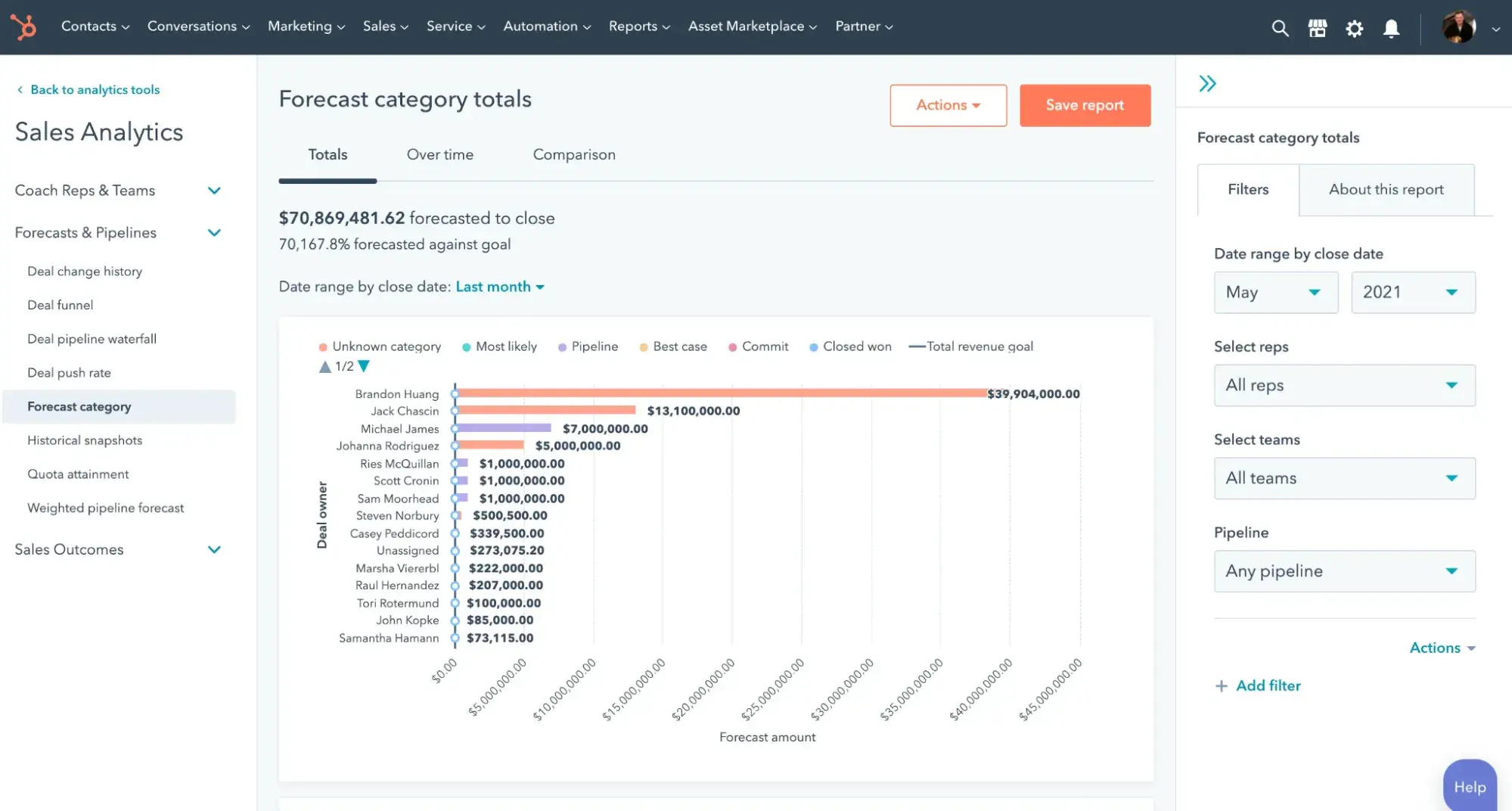
HubSpot’s sales forecasting tool is a platform that gives you a comprehensive overview of your entire sales pipeline so you can make the right decisions for your business. With this tool, I love that you can see how your business has been performing over a specific period and inspect deals to ensure that your sales team is converting the leads that have the most impact on your bottom line.
I find this tool is powerful, easy to use, and has customizable forecast categories that allow you to modify the tool to match your business needs.
What I like: HubSpot’s sales forecasting tool is part of a powerful CRM that gathers sales analytics it can use to correctly predict sales revenue. So if you use HubSpot as your sales CRM, you can directly pull data that will enable you to build accurate forecasts.
Key Features:
- This tool can automatically roll up custom forecasts submitted by sales reps and managers to give business leaders a bird’s-eye view of where their teams will land.
- The forecasts from this tool give managers the ability to drill down into the performance of individual sales pipelines and lead their teams to success.
- This tool pulls data straight from the CRM so that sales teams can see multiple pipelines. This way, both sales and service teams can create pipelines and forecasts.
- This tool gives you in-depth insights into your team’s performance with forecast categories, historical snapshots, weighted sales pipelines, and performance metrics.
Pricing: HubSpot’s sales forecasting tool is available in premium editions of Sales Hub and Service Hub. These Hubs are available at two price points: Professional for $90 per seat/month and Enterprise for $150 per seat/month, billed annually.
2. Anaplan
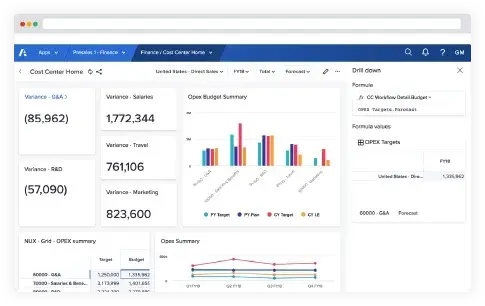
Anaplan is a connected planning platform that caters to large enterprises by offering solutions for finance, operating planning, supply planning, sales and marketing, and HR & workforce management.
Anaplan has a sales forecasting tool that allows sales teams to integrate and analyze data to make informed decisions. With Anaplan, sales managers can make forecasts by account, product line, or territory. I like their “Predictive Insights” feature that helps sales managers identify promising opportunities so they can allocate the right resources to each one.
What I like: Although Anaplan is not a CRM, it does focus on helping the finance, sales, marketing, HR, and operations teams work together to increase revenue. I think this allows for an adequate flow of data and the elimination of data silos that can stunt business growth.
Key Features:
- This tool provides accurate sales forecasts to company leaders, which enables business departments (including finance, sales, marketing, and HR) to make better decisions.
- This tool gives teams a clear view of their sales and revenue, enabling them to analyze these pipelines across different dimensions.
- This tool allows teams to generate sales forecast benchmarks from their historical sales performance and third-party data.
Pricing: Anaplan has three pricing tiers: Basic, Professional, and Enterprise. It offers custom pricing depending on which tier you choose, but you should expect to pay five figures per year at a minimum.
3. Keap
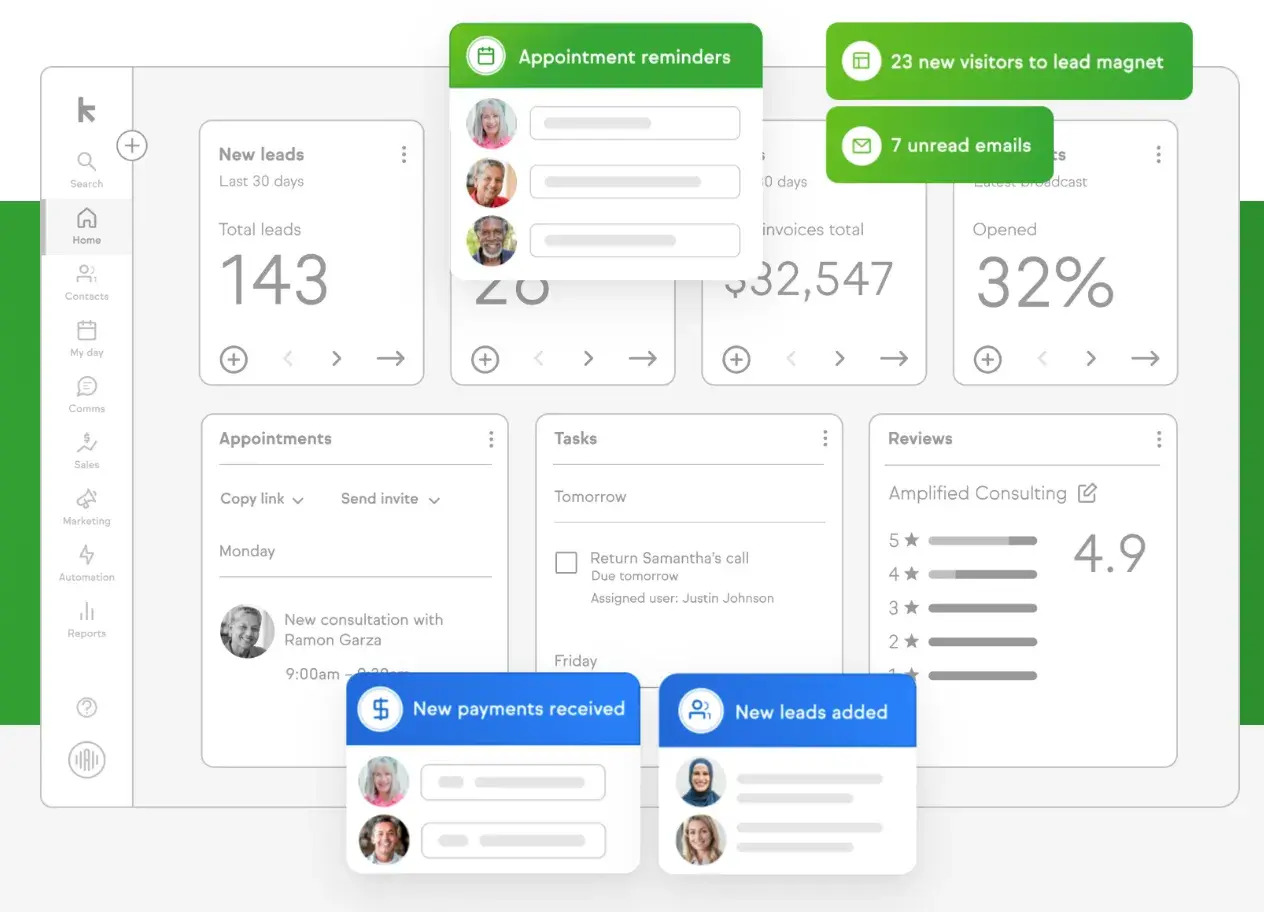
Keap is an all-in-one sales and marketing automation tool that helps small businesses collect and convert leads with its automation, forecasting, and management features.
What I like: Although Keap is a CRM designed mainly for small businesses, it offers seamless integration with many existing sales and marketing software solutions, including BigCommerce, Gmail, Leadpages, WordPress, and Zapier. I think this compatibility creates a smooth marketing and sales feedback loop that makes it easier for sales teams to reach out to and nurture new leads.
Key Features:
- This tool allows users to create multiple, customizable pipelines that sync with Keap’s CRM to convert leads into paying customers.
- Keap’s automation feature takes care of capturing new leads, sending emails and follow-ups, and moving leads through your sales funnel.
- This tool offers analytics that shows you the performance of your sales pipeline. You’ll get access to various reports, including average deal duration, deal conversions by stage, and deal revenue forecasting.
Pricing: Keap used to offer a variety of plans, but the software is currently priced as a complete platform with a minimum of two users for $299 per month. That cost goes up with the number of seats and contacts you need, although you can get a slight discount for paying annually.
4. Pipedrive
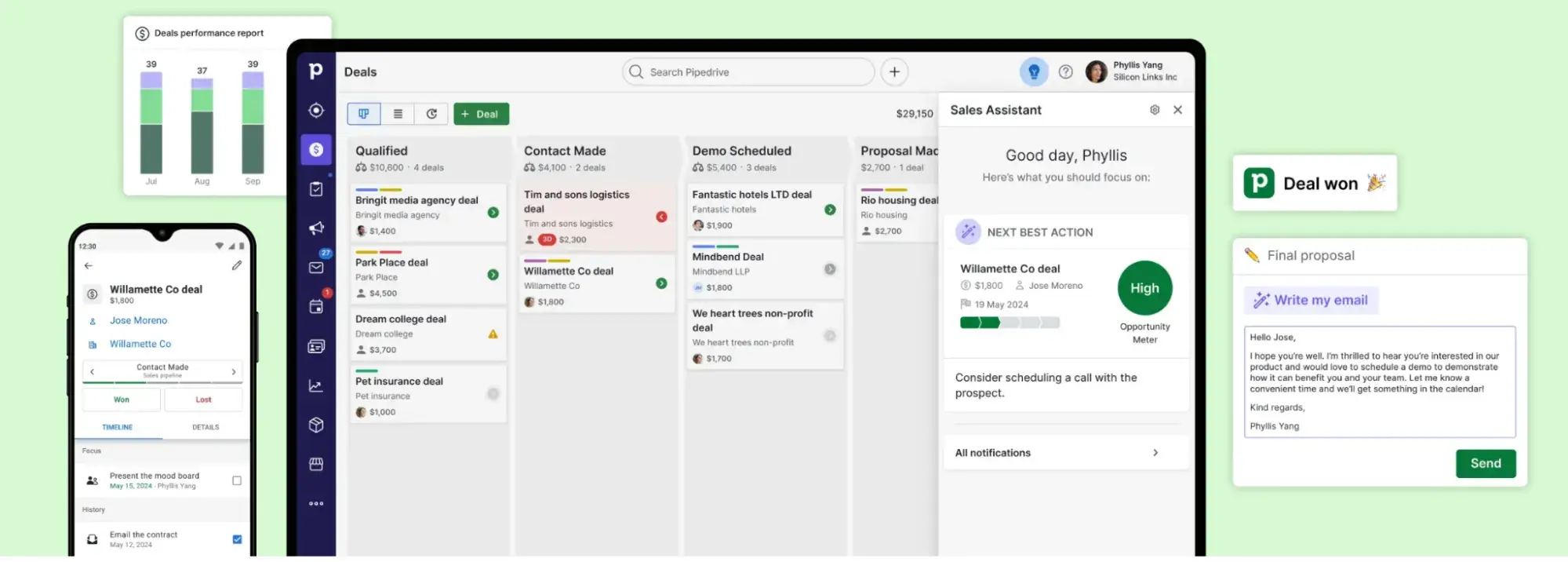
Pipedrive is a sales-focused CRM and pipeline management platform that allows teams of all sizes to set up pipelines, track their progress, and automate growth.
This tool is highly visual and customizable by design, which enables salespeople to see their entire sales process at a glance and customize it to match their sales cycle. Sales managers can use the data Pipedrive collects from their pipeline to project sales volume and revenue.
What I like: Most CRMs cater to different business departments, including marketing, sales, and customer service. Pipedrive prioritizes the sales department and has features that specifically help salespeople meet (and exceed) their quotas.
Key Features:
- Pipedrive automates processes like lead scoring and lead engagement, which frees up time for salespeople to work on tasks that require human insight.
- This tool has deal management features like a custom chatbot, web forms, and real-time pipeline updates that help sales teams generate more leads.
- Pipedrive allows users to categorize, filter, segment, and sort leads to create custom lists they can target with personalized communications.
- Pipedrive provides comprehensive but easy-to-understand sales reports that help salespeople understand the state of their pipelines.
Pricing: Pipedrive offers five pricing tiers. Each is billed annually on a per seat basis. Essential plans cost $14 monthly. Advanced plans cost $34 monthly. Professional plans cost $49 monthly. Power plans cost $64 monthly. Enterprise plans cost $99 monthly.
5. EngageBay
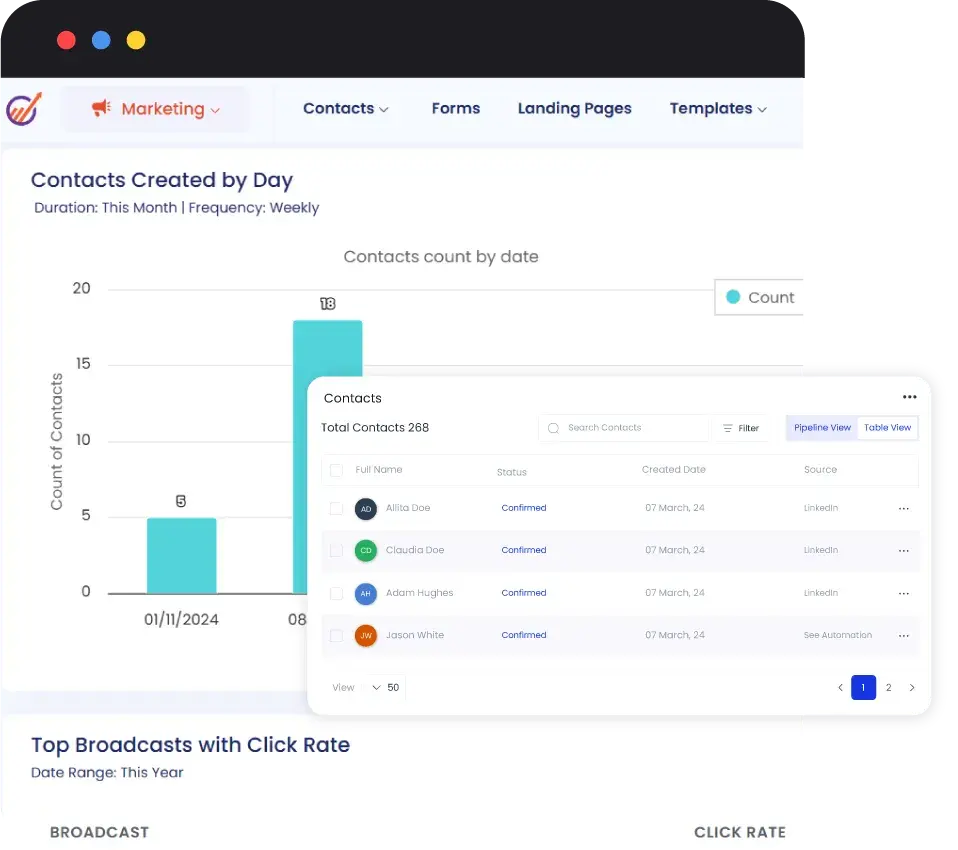
EngageBay is an all-in-one CRM platform designed to help marketing, sales, and customer support teams acquire, nurture, and convert leads. With EngageBay, users can record and analyze their sales and marketing data to make accurate projections and adjustments.
What I like: EngageBay is an integrated solution that has everything customer-facing business departments need to guide prospects through their buyer journey.
There are powerful marketing tools, including email marketing, marketing automation, lead generation, and social suite tools. There’s also a free CRM that helps users store customer information and a slew of sales tools that allow users to create multiple deal pipelines, automate sales processes, and send email sequences.
Finally, there are service tools such as Help Desk, Feedback Forms, and Knowledge Base that allow the customer support team to offer better service to customers and prospects alike.
Key Features:
- EngageBay allows you to run as many deal pipelines as you need. You can use the preset filters to categorize active pipelines.
- With EngageBay, you can track and get insights into what your customers do and how they behave on your website.
- If your sales team failed to meet their quotas due to a lack of enthusiasm, I love that EngageBay’s sales gamification feature allows you to create a friendly competition among your sales reps to encourage them to put in their best.
Pricing: EngageBay has a free version, with paid plans priced per user per month. Basic plans cost $12.74 monthly. Growth plans cost $55.24 monthly. Pro plans cost $101.99 monthly.
Tips for Making Sales Projections
If you’re starting the sales projection process from scratch, it can be difficult to get accurate numbers. Here are my tips for making sure your sales projections are informative and trustworthy.
1. Know your sales figures.
A sales projection should be rooted in actual data. Before making a projection, I recommend calculating your past and current sales figures.
Figure out how much revenue your business has generated in the past couple of months. Then, analyze your current sales pipeline, including prospects, leads, and closed deals. Calculate your win rates and conversion rates, and use these figures to project the number of deals you’ll likely close in the near future.
Knowing your sales figures will help you make a realistic projection that sales reps will be able to deliver at the end of the projection period.
2. Study industry trends and benchmarks.
Paying attention to industry trends can help you anticipate changes in customer behavior.
Brandon Kent, the vice president of Telemark Diversified Graphics, advises that salespeople “research industry benchmarks and compare your projections against similar businesses or competitors. This helps validate your assumptions and provides a benchmark for performance.”
I think Kent is right. Companies like Forrester and Gartner keep a close eye on industry trends and compile them into reports that can come in handy when you’re making sales projections.
3. Collaborate with various business departments.
To get more accurate projections, I suggest involving team members from different departments, including finance, marketing, operations, and product. I find this helps you gather diverse insights and perspectives into how their initiatives may impact future sales.
For example, if the marketing team is rolling out a brand new campaign, you’ll likely get more leads from that, so you should factor it into your sales projections.
4. Use customer data.
Customer data is an important part of sales projections because it can help you understand the customer groups that are most likely to purchase your product(s) — and the kinds of products they go for. For example, if I sell products that are popular with busy moms, I might want to focus my sales projections on this demographic.
Alister Wood, the owner at VisitUs, knows the critical role customer data plays in sales projections. “Examine factors such as the total number of customers, average order size, frequency of order, and any seasonal trends that may have affected the prior year’s revenue numbers,” he says.
“Having this information will help you accurately assess where future revenues will likely come from based on existing sources, rather than relying solely on speculation about future prospects and business opportunities.”
5. Stay flexible.
I know it’s easy to feel as though your sales projections are set in stone and should be the benchmark that every business department aspires to. But this shouldn’t be the case. Your sales projection should be a flexible number that gives you an idea of how much revenue you’ll generate so you can prepare adequately for it.
“You don’t want to get so wrapped up in your projections that they become an inflexible goal that drives everything else in your company’s strategy or product development efforts — or worse, makes them seem unattainable when they aren't actually impossible after all (just very difficult),” says Gauri Manglik, the CEO and cofounder of Instrumentl.
“Keep an open mind about what might happen next year and adjust accordingly so you don‘t end up feeling like a failure when things don’t go according to plan.”
6. Use a sales forecasting tool.
A sales forecasting tool can make it much easier and quicker to come up with accurate sales projections. According to Manglik, using a forecasting tool can “tell you exactly how many leads turned into actual customers in previous years, at similar times of the year, and in similar markets as yours.”
I find these analytics ensure that you make projections that are based on data, rather than wishful thinking — because while your projection should be aspirational, it should never leave the real world behind.
Make Better Sales Projections for Your Business
The sales department keeps the lights on, which is why a sales projection is a crucial tool that informs so many different aspects of a business. In my time in sales, the organizations that take sales projections seriously have consistently outperformed the ones that relied on intuition and luck to cobble something meaningless together.
And that makes sense. At the end of the day, the entire company, including individual contributors on the sales team, needs to trust that a projection was put together for the right reasons and not vanity metrics. Otherwise, a sales projection is just a siren leading your people astray.
Sales Forecasting



![How to Choose the Right Forecasting Technique [+ Expert Insight and Data]](https://53.fs1.hubspotusercontent-na1.net/hubfs/53/forecasting-methods-1-20241205-4072635.webp)
-Feb-24-2025-07-49-23-4986-PM.png)






![I Took a Deep Dive Into Trend Forecasting: Here’s What I Learned [+ Expert Tips]](https://53.fs1.hubspotusercontent-na1.net/hubfs/53/trend-forecasting-1-20241114-1048511.webp)
